A guest entry
As I mentioned in my previous entry, I have a treat for you: the second guest entry on this blog! The text has been written by Textile Conservation student Emma Hartikka (also Finnish, so I get to promote Finnish know-how too!) who was on a placement with Zenzie Tinker. I hope you find the entry as fascinating as I did…
“A few years ago, two carpet samples from the University of Brighton Design Archives were conserved at Zenzie Tinker Conservation by Emily Austin, a Textile Conservation student at the time. She wrote a guest entry about the project. Two other carpets samples from the archives were conserved at Zenzie Tinker’s again – this time by conservators Geoffrey and Jamie from the studio and me, a Finnish textile conservation student from Metropolia University of Applied Sciences and a summer intern at the studio. I will follow Emily’s lead and write another guest entry about the newly conserved carpet samples.
Both of the carpet samples at hand date to the late 1950’s and have quite bold graphic designs. One of them has a green and black geometrical pattern and the other a rotating pattern in three different shades of blue on a darker, blueish-green background. Their pile is wool and the back weave jute and cotton. The piece mentioned first is a sample of Axminster Body Carpet with the design “Royal Gobelin”. The pattern of the carpet was designed by Neville and Mary Ward and the carpet made by Tomkinsons Ltd. The second piece is a Wilton Body Carpet with a pattern called “Mandala”, designed by Audrey Tanner. This carpet was made by The Carpet Manufacturing Company Ltd. Both designs were recognised and awarded The Duke of Edinburgh Design Prize for 1958 and 1959 respectively.
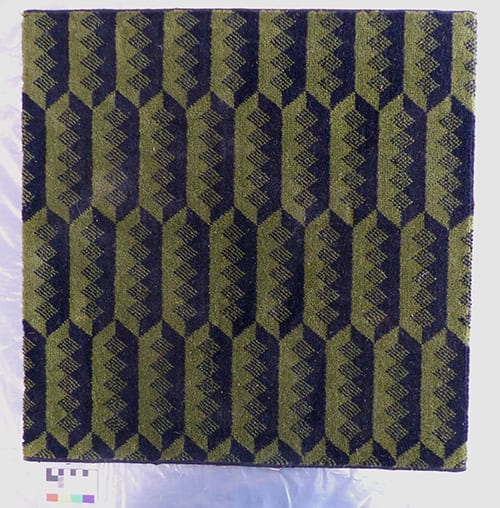
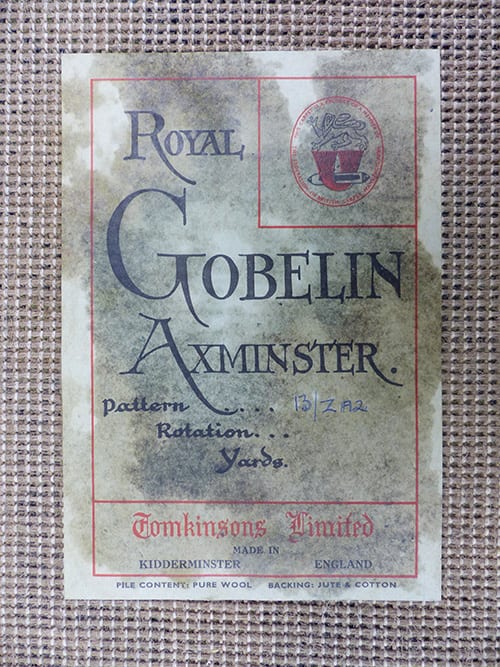 Images (above): The “Royal Gobelin” carpet sample and its label before conservation.
Images (above): The “Royal Gobelin” carpet sample and its label before conservation.
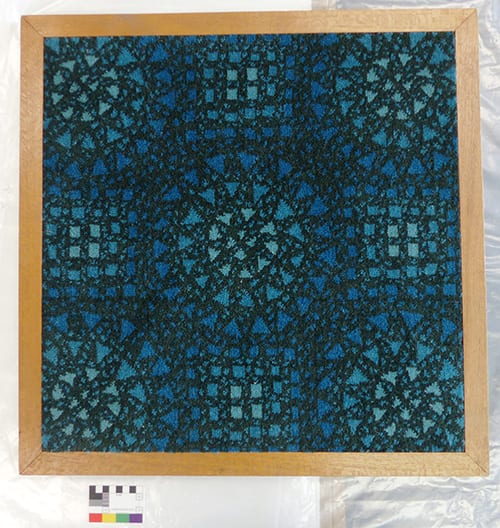
 Images (above): The “Mandala” carpet sample and its label before conservation.
Images (above): The “Mandala” carpet sample and its label before conservation.
The goal of the project was to do the necessary conservation treatments and remount the carpet samples in order to improve their preservation and use for research. The condition of these samples was relatively good, much better than the other two carpet samples previously conserved at the studio. Like the previous ones, these two had also been victims of a moth infestation. They had piles of moth droppings, such as casings and eggs, found especially between the carpets and the wooden panels on which the pieces were mounted. Luckily, the moths hadn’t done much damage here as they had to the previous two. There were only a few little spots where some woollen pile was missing. However, to kill any possible remaining ravenous moth babies the carpet samples had to go through freezing before anything else could be done to them.
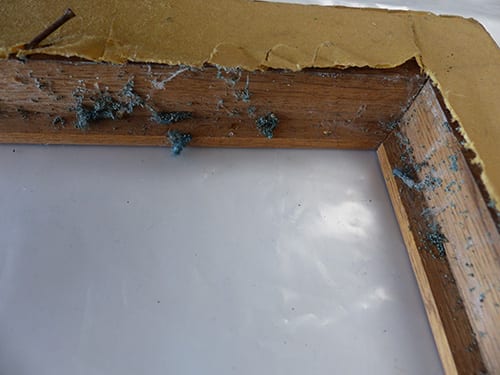
 Images (above): Moth droppings on the wooden frame and on the edge of the carpet sample.
Images (above): Moth droppings on the wooden frame and on the edge of the carpet sample.
The carpet samples were prepared for freezing by removing the old wooden panels and vacuuming the worst of the surface dust and moth droppings off. Otherwise the dust could be stuck to the textile fibres even tighter if condensed moisture dampened the textile during the freezing process. To prevent that from happening, the samples were also wrapped in acid-free tissue and polyethylene plastic as air-tightly as possible. The temperature of the freezing process must be low enough so that even the tenacious, more cold-resistant eggs are eliminated. Research has shown that -30°C is low enough to kill the eggs. Due to the unseasonably warm weather during the late summer, the studio freezer was only reaching -25°C, so a decision was made to freeze in two parts: firstly, 75 hours in -25°C, then 24 hours in room temperature and finally a further 75 hours in -25°C again. The day’s warm period in-between imitates a warm spring encouraging the eggs to hatch. The newborn, vulnerable larvae would be then killed by the second winter. It sounds kind of harsh but it can save the object!
The blue carpet sample had cotton tapes supporting the raw edges glued along the edges on the verso but the old adhesive was dry, brownish-yellow in colour and giving away. The cotton tapes were therefore removed. They gave away easily by simply pulling lightly. Then dried adhesive was scraped away with a spatula.

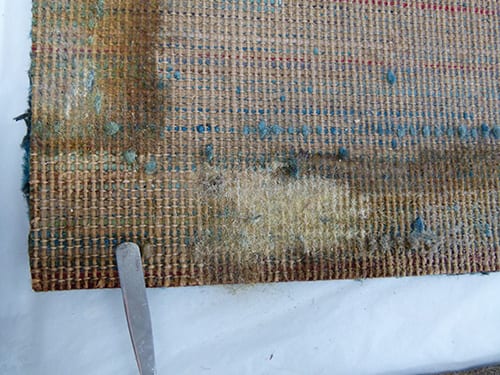 Images (above): The old cotton tapes were removed and the crusty, dried adhesive scraped off.
Images (above): The old cotton tapes were removed and the crusty, dried adhesive scraped off.
In some places the adhesive was still sticky and couldn’t be scraped off. Some solvent cleaning tests were done to find an effective substance for removing the remaining adhesive. A mixture of petroleum spirit and a solvent called Rhodiasolve proved to be effective to soften the adhesive enough so that it could be removed but would not penetrate deeper into the weave structure. The swab cleaning was performed successfully by conservator Geoffrey. His method of scraping off the remains of the softened adhesive with a round brush was simply great.
 Image (above): The sticky adhesive being removed with the help of a solvent mixture.
Image (above): The sticky adhesive being removed with the help of a solvent mixture.
After solvent cleaning, both carpet samples were vacuumed carefully to get rid of any remaining surface dust, moth bits and loose pieces of adhesive. The raw edges of blue carpet sample were fraying and had to be supported with cotton tape and blanket stitches along the edge. The other piece had more stable edges which didn’t need extra support.
Then it was time to make padded boards for the samples to be mounted on! The principle of the process was similar to what was done for the previous two carpet pieces. Two strips of Velcro tape were stitched both to boards and the reverse side of the objects. This gave a means of attaching the carpet samples to the boards so they could be easily detached if someone wished to take a look at the labels on the verso. Care was also taken not to cover the labels with Velcro or cotton tapes. Finally, the labels were protected by covering them with a piece of see through Melinex film.
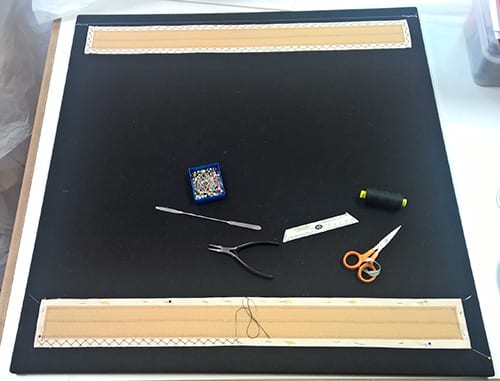
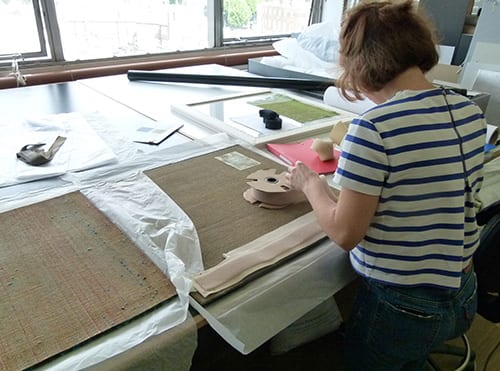 Images (above): A padded board in the making and Jamie preparing the Velcro.
Images (above): A padded board in the making and Jamie preparing the Velcro.
After conservation, the carpet samples are now cleaner, more stable and moth free. The new mounting system makes the research of them easier. They are now ready to return to the Design Archives to join the other two previously conserved pieces!”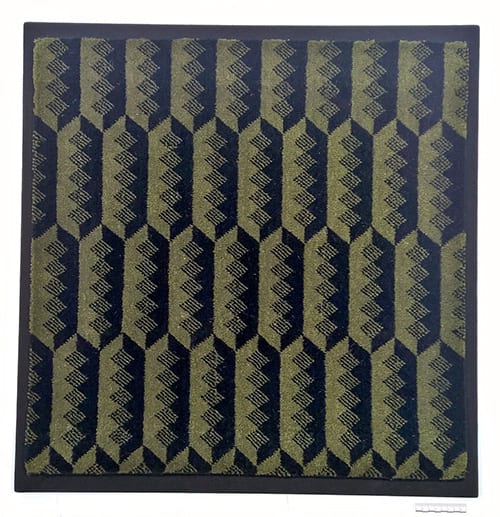
 Images (above): The recto of the green carpet mounted after conservation, and the verso of the blue carpet after conservation, before mounting.
Images (above): The recto of the green carpet mounted after conservation, and the verso of the blue carpet after conservation, before mounting.
On that note, I want to wish you all the best of Season’s Greetings as this year rolls towards its end. The Design Archives have a big year ahead in 2019, and I am hoping I will get a chance to write a little more about that in due course! So keep your eyes peeled…
